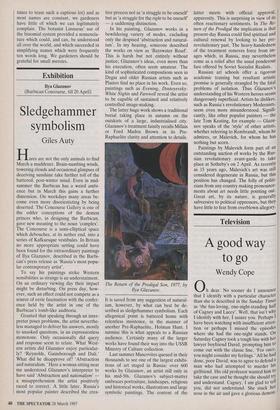Gardens
Rosa by any
other name
Ursula Buchan
To the outside world, the line between the botanist and the horticulturist is rather fuzzily drawn, seeming more a matter of nomenclature than substance. Botanists are concerned with the classification and naming of plants, whereas horticulturists are cultivators of plants and care little, if at all, for the way their charges come to be named. Botanists are sometimes also gardeners, almost as interested in living flowers as in dried herbarium specimens; gardeners are hardly ever also botanists. The botanist seeks diligently after a realisable truth, that is, the correct name for a plant. Since the mid-18th century, When Linnaeus classified all known plants and animals using the binomial system, names have consisted of a generic term (akin to a surname but coming first) followed by a specific epithet (like a Christian name but put second). The classi- fication is based on the sexual characteris- tics of the plant. In this century the introduction of the International Code of Botanical Nomenclature has standardised and simplified the naming of plants still further, but it has enshrined the apparent absurdity (t,- gardeners, at least) of the Principle of 'priority'. In the process of establishing 'priority' (the earliest record of the naming of a particular species) or When taking account of advances in tax- "only, the botanist may have to correct the imprecision or ignorance of earlier botanists by making name changes. Re- naming a plant may involve putting it in a different genus or even family. The professional horticulturist, on the Other hand, is not the slightest bit in- terested in whether de CandoIle named this plant 'x', or whether Linnaeus got there first with 'y', or whether both men were even referring to the same plant. Nor does he understand why some botanists ( luinpers') put species together under one name and others ('splitters) are keener on dividing them up. The gardener craves certainty, as the botanist does, but for him that means preserving the status quo. Nothing infuriates him more than to have grown for many years the South African, half-hardy, blue-flowered Agapanthus umbellatus, only to find that when he orders an interesting 'new' species called A. africanus from a catalogue he receives yet more of the plant which he already Possesses. What does he care that the new name is earlier and botanically more cor- rect? Botanists renaming plants has led to gardeners renaming botanists.
Just as cross and loud in complaint is the average amateur gardener, whose know- ledge of the classics is a little shaky. His irritation is not so much with name- changes as with the names themselves. He thinks he would much rather that Agapan- thus africanus could be found in catalogues as 'African lily' and wails that it is a great shame that people cannot call plants by their proper names. He forgets of course how many 'Latin' names like Clematis he uses as a matter of course.
There is reason enough to retain in use the common names of native British flow- ers, and most gardeners, if they are not too pedantic, would prefer heartsease to Viola tricolor and primrose to Primula vulgaris, but the eight regional names for the marsh marigold (I mean marsh buttercup, sorry, mollyblobs, no, kingcup) makes one fall back with gratitude on the universal com- prehensibility of Caltha palustris.
I would readily concede, therefore, that this is a matter about which we are none of us entirely consistent, particularly because even the Latin or Greek can sometimes be misleading. For example, Rosa centifolia has a hundred (i.e. many) petals, not a hundred leaves as the name would suggest.
The controversy surrounding this subject is anything but new. A hundred years ago, William Robinson (a horticultural polemi- cist of genius much influenced by John Ruskin's dottier outpourings) translated many of the names of plants he used in The Wild Garden into English, in a laudable but misguided attempt to make life easier for the ordinary gardener. In the process he allowed himself to fall into the absurdity of spurious anglicisations such as 'rockfoil' for Saxtfraga and 'hair bell virgin's bower' for Clematis campaniflora (I should feel a reticence about asking for the latter in my local nursery). Some plants, such as roses and daffodils, have been around so long in many cultivated forms that it is neither necessary nor even desirable to mention their Latin names but is anybody the wiser if Agapanthus is called by its English name? 'African lily' tells us almost nothing useful about the plant; indeed, as the plant is not a lily the name is positively mis- leading.
I am no botanist (although so vague is the world's perception of the difference between botany and horticulture that I am frequently introduced as one) but in this matter I side with them against my own kind. I have worked with very able young gardeners whose written English was un- certain, but who had no difficulty, because they had no choice, in learning to say and spell Metasequoia glyptostroboides or Gen- tiana przewalskii.
It seems to me that, as botanists do not change names merely to infuriate garden- ers (although it must be tempting some- times to tease such a captious lot) and as most names are constant, we gardeners have little of which we can legitimately complain. The botanist Linnaeus' use of the binomial system provided a nomencla- ture which could, and can, be understood all over the world, and which succeeded in simplifying names which were frequently ten words long. We gardeners should be grateful for small mercies.



















































 Previous page
Previous page